As February winds to a close, it seemed like a good time to get started on the TLG guide we promised you. But here’s the thing: the TLG is a big project. It’s scary. And so we procrastinated for a really long time before finally deciding that partial was better than never.
In some ways, this story is similar to the (apocryphal?) story of the TLG itself. Way back when, in the pre-digital era, the TLG was behind its Latin counterpart, the TLL. (There is a lot more surviving Greek literature; before Intel, filing was done with index cards.) When computers came along, making a database of surviving Greek texts seemed like a possibility, and after several iterations on CD-ROM, the online TLG was born. The website now includes both texts and an online, searchable Big Liddell (with some other lexical tools).
Why would you use the TLG? It is the largest compendium of Greek texts (in Greek) that exists. It is a million times better than having to retype any given bit of Greek that you want into a word processor. And it lets you compare word usage (or search for a given concept) across over 2000 years of Greek literature — the TLG includes everything from Homer to Byzantium.
In other words, why wouldn’t you use the TLG?
This is a subscription-only service; you either need to pay for access or belong to an academic library (there is an abridged version that is free, but if you’re using the TLG, you probably want to use it all the way). I’m going to assume that everyone can get through their own single sign-on system to access digital resources at home and start from the welcome page.

We’ll cover making an account later; for right now, pretend you’re just browsing. I highly recommend using the Unicode site — mainly because you like reading Greek, not gibberish, right? For those of you who have never had the joy of reading Betacode, here is a transliteration of lines 1-2 of our final result below:
ἐπειδὴ τοῦ χρόνου προϊόντος ἠνδρώθησαν
epeidh` tou^ xro’nou proio’ntos hndrw’qhsan
I don’t know about you, but I can only understand one of those. If you’re planning to read a substantial amount of Greek — and if you’re not, why are you on the TLG? — Unicode is much, much easier.
So, on into the site! Your main options will be to search and to browse. Despite what the title says, if you know what you’re looking for, you want to browse — and that is called “searching”. We’ll be covering that today. If you don’t know what you’re looking for (for example, you want to know every time Hera appears in Greek literature), you do not use this screen; you use the tools on the left sidebar, and we will cover that in a follow-up post.
This is the screen for when you just want to grab a bit of text. Let’s say you’re looking for the Hellenistic historian Diodorus Siculus. (Don’t ask why you would be looking for him — there’s a surprise at the end.)
Unless you’ve memorized the TLG, the easiest way to search is by letter. If you work on a single author, you may one day learn his TLG # and be able to input that in the top box. As a historian, I confess that I have never learned any TLG numbers, and because the Greek names aren’t necessarily what you’d expect, I find browsing by letter to be much easier.
If you did want to search by name, here is what it would look like:
It doesn’t matter if you capitalize; you do need to spell correctly, which means Latinized in the case of the TLG.
You will get a list of every TLG author with that name. Sometimes, this is easier than others, depending on how many authors share any given name (hint: there are a LOT of people named Dionysius, and rather fewer named Bacchylides).
Remember, we’re looking for Diodorus. So we pick “B-D”. Unfortunately, as you can see, there is no way to further refine these alphabetical results:
Now, at this point, if you know anything about Greek names, you should be getting a little nervous. Why? Because “Dio-” is a theonym, and a pretty common one.
This is just a small selection of the Dios. (And, to make it more confusing, Cassius Dio is under ‘C’). So once you are on the B-D page, I recommend searching for whomever you want. In this case, to get Diodorus, “Diod” is a good string. Click on his name, and you can make sure you’ve got the right Diodorus Siculus (silly in this case; in others, it might be less clear!)
Now you need to wade through a series of definition screens before you can actually get to the text. So first, “show works”:
Again, while this is perhaps less helpful in the case of Diodorus, it can be extremely useful. Imagine you’re trying to read Aristophanes (the comedian, not the grammarian — and now you see where all of the guide pages become necessary). Maybe you only care about the Frogs. You can choose just the single work (they are listed with Latin titles, so “Ranae”), rather than all of them.
When you choose the work, pay attention to the details the site gives you. You’re getting information about the edition used (especially useful in the case of fragments, as Diodorus #2), including all publication information — usually it is the Teubner, but sometimes the TLG uses the OCT. Word counts for the text can be useful if you’re comparing the length of different plays or orations (for example). And finally, if there is a free translation into English, the TLG links to it — so if you know that Diodorus talks about early Rome, but you’re not sure where, you can find it in the English before searching the Greek.
Once you’ve determined what you want to read, click on “browse”.
You can either start reading right away, or you can use the buttons to go to a particular part of the text. So if you’re looking for early Rome, and you happen to know that it’s Diod. Sic. 8.5 (because you are a crazy person, like me), you can use the drop-down menus to go to book 8, chapter 5:
Note that because Diodorus 8 is fragmentary, this takes you to the TLG page that includes 8.5. The section you want is in the middle, rather than at the top. This will be true for all TLG texts — you may need to scroll down before finding the part that you want. This is because the TLG pages are static webpages, rather than offering the entire text on a single page.
A few important things to keep in mind:
- the highlighting does not turn off, and the formatting will copy into your word processor if you’re trying to quote the text. That formatting includes the line numbers, the crazy @ symbol, and all line breaks. So be careful when you’re proofreading.
- The last line of every page is repeated as the top line of the next page, so you can sort of still read with the grammar in mind.
- The TLG is 99.9% reliable for the texts that it represents. But if you are an advanced student (a graduate student, rather than an undergrad), you will want to
- check your edition and make sure you’ve made it clear that you’re using the TLG’s text
- check your accents — I am forever impressed by one of my peers who, in reading over one of my dissertation chapters, found a missing accent in this very passage of Diodorus (I believe it has now been fixed).
- Finally, the site here tells you where each fragment of book 5 comes from, but doesn’t link to it — so if you want to read the quote in context from Constantius, you need to look it up separately.
As for that surprise — who knew that one of the minor fragments of Diodorus is Remus getting hit in the head with a shovel? (Well, I guess I did…) In any case, happy reading!

Help with Greek texts: TLG part 1 (Browsing) by https://libraryofantiquity.wordpress.com is licensed under a Creative Commons Attribution 4.0 International License.



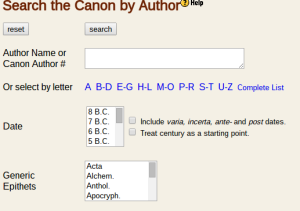

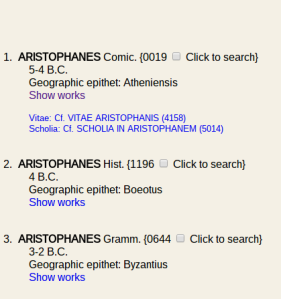
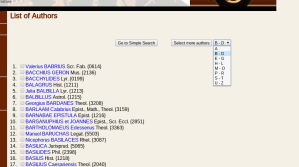
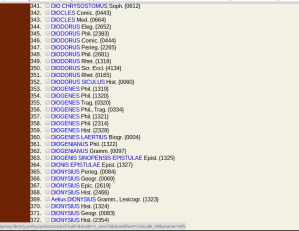
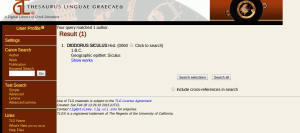


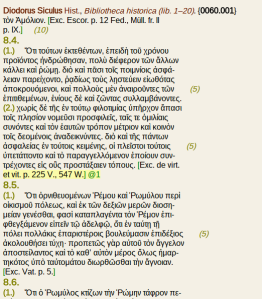
[…] reminds us that we need to post a tips section for the TLG, so look for that coming this weekend! (** update 2/16: the Toronto flu has finally hit us, so we […]
LikeLike
[…] our first post, we covered the basics: how to find a text you already know exists. But sometimes you might need to […]
LikeLike
[…] far, we’ve covered how to find various texts or words in the TLG. In these last posts, we’re going to examine how to do some things that […]
LikeLike
[…] people are unfamiliar with the joy that is (was?) beta code. Beta code is a pre-unicode standard for writing in non-Latin characters. Way back in the day […]
LikeLike
[…] the TLG or PHI […]
LikeLike
[…] original language. Therefore it is not possible to draw conclusions about the whole of Latin or Greek texts from Perseus searches. But if you know that all the works you need to search are on Perseus, then […]
LikeLike
[…] a year ago, we started a series of posts on the Thesaurus Linguae Graecae, or TLG. For various reasons, this series was never […]
LikeLike
[…] useful Classics tools. Last year, we laid out how to use the ‘classic’ interface in a series of posts. And then (of course!) the site updated, with a completely new look and some new features. […]
LikeLike
[…] a word, text, or author using basic search functions. That’s all pretty much the same as the old TLG, although the interface is new. This post moves on to some of the New TLG‘s features. […]
LikeLike